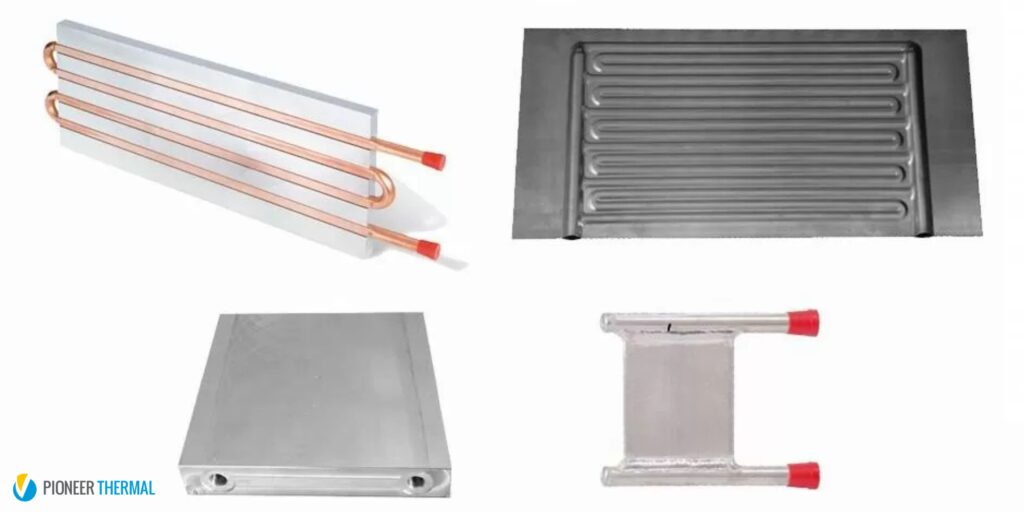Cold plates for electronics are the most effective way to cool high-power devices that generate more heat than fans or standard heat sinks can handle. You can’t ignore this if your equipment gets too hot.

When you use high-performance electronics, such as power inverters, telecom units, or industrial machines, heat can be a significant problem. It’s not just an option to get cold plates for electronics. They are crucial for keeping these devices safe and extending their lifespan. Cold plates cool things down directly and quickly by moving heat away from the source, unlike fans or other cooling systems.
Let’s examine it in more detail to see why cold plates are more important than ever.
How to Keep Electronics Cool with Cold Plate Integration
Cold plates cool things down by using a liquid, typically water or a mixture of water and glycol. The fluid moves through channels in the metal plate, which is in contact with the hot parts. This setup takes heat away much faster than air does.
Cooling with fans and airflow is helpful in systems with less power. However, when the heat output is too high, the airflow is insufficient. Cold plates are ideal for small spaces and demanding tasks. They run quietly and efficiently without needing big fans or vents.
For instance, Pioneer Thermal manufactures cold plates tailored to meet the specific needs of each system. Their custom solutions help keep things from getting too hot and maintain steady performance.
Why You Shouldn’t Only Use Passive Cooling
Here’s the truth. There are limits to how well standard heat sinks can cool things passively. When your system is equipped with powerful components, even the best heat sink suppliers can only do so much.
- Cold plates help dissipate heat more effectively in small or confined spaces.
- More direct cooling for sensitive parts
- Flexible design for complicated setups
This is particularly helpful in electric cars, medical devices, and communication systems, where downtime can be extremely costly.
How Different Heat Sink Suppliers Compare for High-Performance Cooling
Many people begin with basic heat sinks because they’re easy to install and use. Good suppliers of heat sinks have a wide range of sizes, materials, and shapes to choose from.
Cold plates are the next step when your system requires more cooling than a metal block can provide.
They don’t just use air; they also actively use liquid to remove heat. That means your electronics can work harder and longer without overheating.
If you’re unsure about making the change, a trusted supplier can help you test and develop the best solution for your needs.
Why Cold Plates Are Often Recommended by Heat Sink Suppliers
Parts with a lot of power, such as motor controllers and RF amplifiers, generate hot spots that fans and heat sinks can’t cool down quickly enough. That’s why experienced heat sink suppliers often recommend using cold plates for more challenging jobs.
Cold plates enable engineers to control the temperature more effectively. They also help you design systems that are smaller and more compact. You can put them in tight spaces or sealed enclosures because they don’t need airflow.
Remember that cold plates work best when planned for early in the design process, rather than as a last-minute fix.
What Heat Sink Suppliers Say About Designing a Good Cold Plate
Are you thinking about using cold plates in your design? Some advice from experienced heat sink suppliers is as follows:
- Verify that your fluid flow is correct. Too fast or too slow can affect your performance. Make sure the contact surface is flat and smooth. Gaps make it harder for heat to move.
- Pick the right material. Copper conducts heat better than aluminum, but aluminum is lighter and less expensive.
- Check the pressure, though. Your pump can get stressed out if the pressure drops too much.
- Planning will help you avoid problems with time, money, and performance in the future.
Final Thoughts
Cold plates are a simple and reliable method for cooling high-power electronics. They remove heat more effectively than fans or standard heat sinks, especially in tight spaces or high-usage systems. By using liquid to carry heat away, cold plates help protect your components and maintain smooth operation. If your system generates a lot of heat, it’s smart to plan for cold plates early. This can save you time, money, and future problems.
FAQs
What do cold plates do in electronics?
Cold plates cool power parts by transferring heat away from the device using a liquid.
What are the differences between cold plates and heat sinks?
Cold plates are better suited for systems that generate excessive heat because they utilise liquid cooling. Heat sinks only use air and can hold less.
What kind of liquid goes into cold plates?
Most people use water or a mix of water and glycol. For safety, some systems use special liquids that don’t conduct electricity.
Can cold plates be used in everyday electronics?
Not usually. They are used in industrial, automotive, or medical systems that need better cooling.
